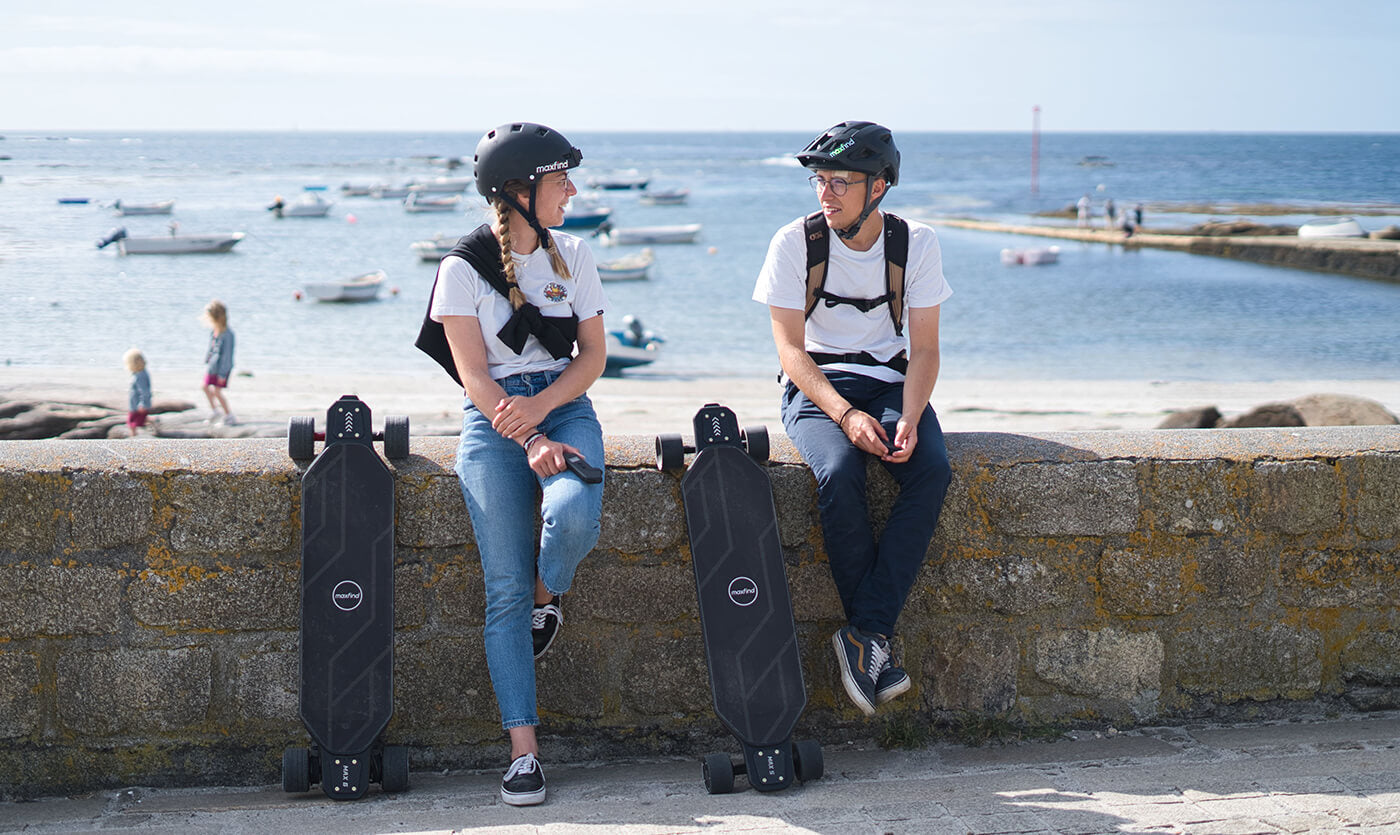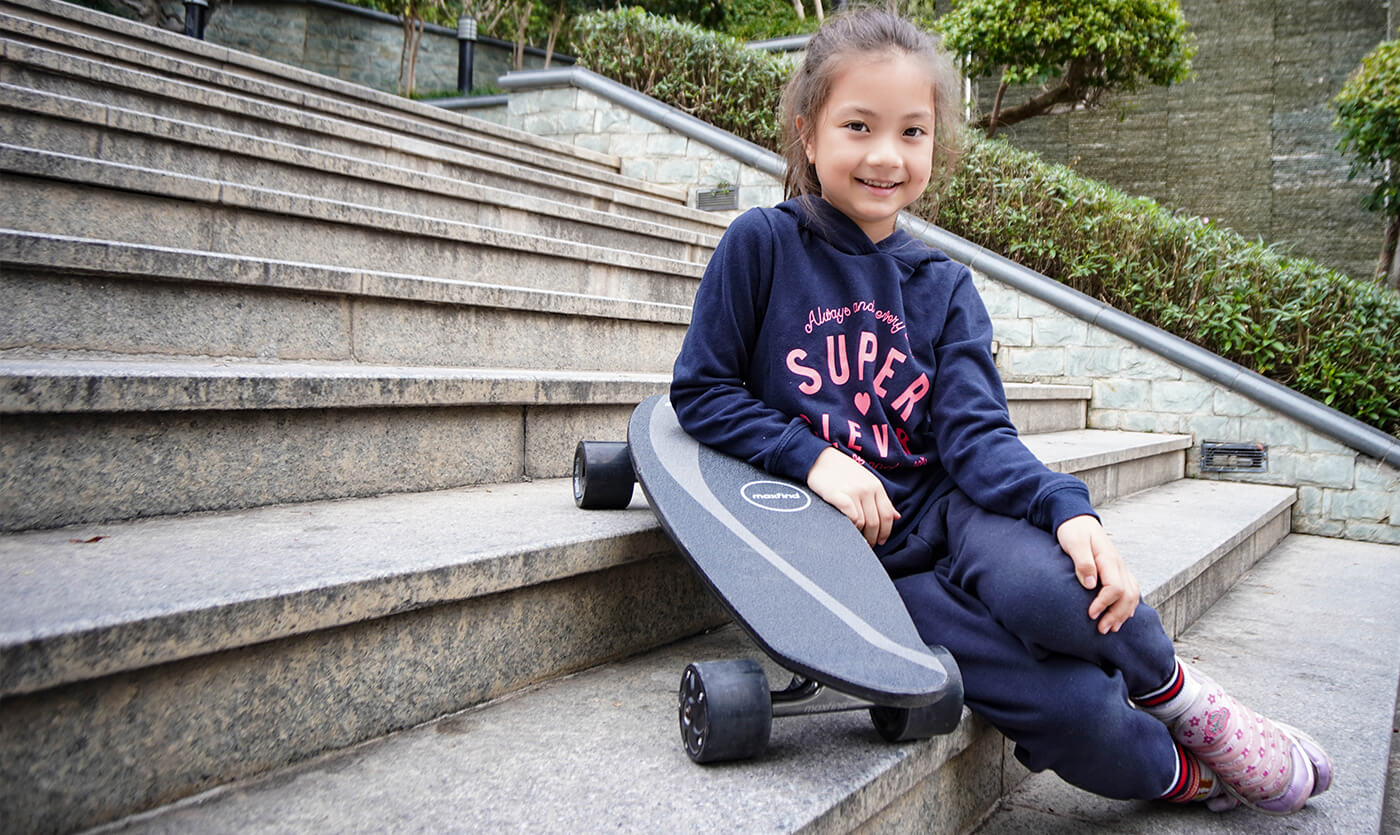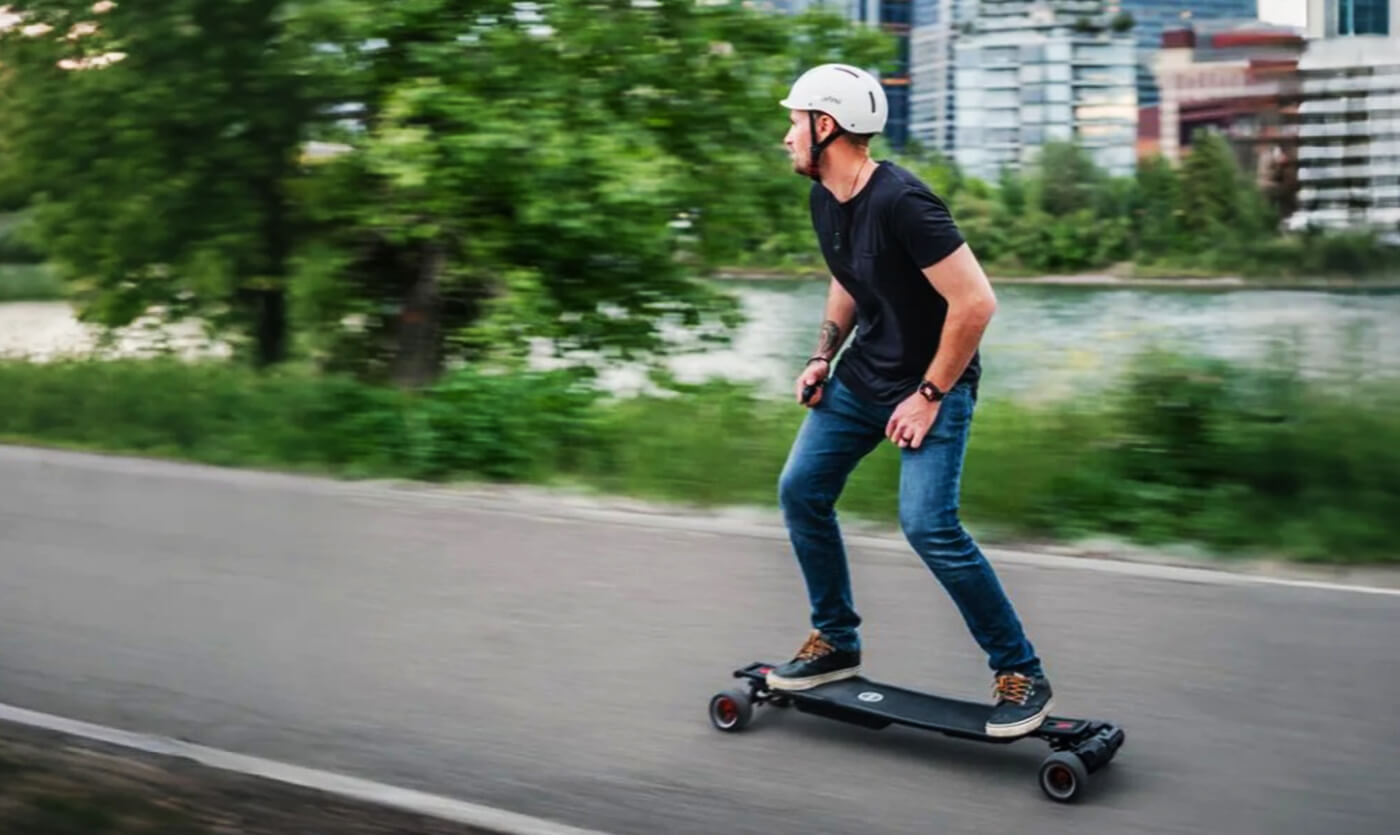Trage einen zertifizierten Helm, Handgelenkschützer-Handschuhe, Knieschützer, Kevlar-Jeans und griffige Schuhe, dann schichte atmungsaktive oder wasserdichte Jacken und füge reflektierende LEDs hinzu, um sicher, bequem und legal zu bleiben. Dieser Leitfaden erklärt Ausrüstung von Kopf bis Fuß, Klima-Tipps, Stil-Kombinationen, Budgets, Pflege und wichtige Gesetze in einem Durchgang.

Sicherheit zuerst – Warum Ausrüstung wichtig ist, bevor du das Board einschaltest
Typische Unfall-Szenarien und die am stärksten verletzten Körperstellen
Jeder Sturz mit dem elektrischen Skateboard ist eine Physikstunde: Je höher die Geschwindigkeit, desto härter die Landung. Neue Fahrer fangen meist ein Rad an Schmutz oder bremsen zu stark und fliegen nach vorne, landen auf Händen, Knien und Gesicht. Erfahrene stürzen öfter bei 40–65 km/h beim Beschleunigen aus einer Kurve heraus.
Krankenhäuser melden drei Hotspots: Kopfverletzungen, Handgelenksbrüche und Hautabschürfungen an Hüften und Oberschenkeln. Das Verständnis dieser Schwachstellen leitet jede folgende Ausrüstungswahl.
Schutzausrüstungsstandards einfach erklärt (CPSC, ASTM, CE)
-
CPSC 1203 – Der grundlegende US-Fahrradstandard, geeignet für Fahrten unter 32 km/h.
-
ASTM F1952 – Downhill-Skate-Standard; 3× die Aufprallenergie von CPSC, ideal für über 40 km/h.
-
EN 1621-1/-2 & CE Level 2 – Aufprallschützer für Ellbogen, Schultern, Wirbelsäule, Hüften, Knie.
Wenn ein Produkt nicht mindestens eines dieser Prüfzeichen aufweist, lass es weg; Aufkleber sind kein Marketing-Gedöns, sondern Unfallphysik in winziger Schrift.

Schutz von Kopf bis Fuß – Das Wesentliche
Helme – Dual-Zertifizierung vs. Downhill, Vollgesicht vs. Halbschale
Dual-zertifizierte Halbschalen (CPSC + ASTM) bieten Luftzirkulation und leichten Komfort bis zu Pendlergeschwindigkeiten. Downhill-Vollgesichtshelme fügen eine Kinnschutzstange, dickeren EPS-Schaum und splitterfreie Visiere hinzu für alles über 40 km/h oder für Fahrer, die einfach einen Schutz zwischen Zähnen und Asphalt bevorzugen.
Tipp: Wähle den Helmstil passend zum Fahrstil, nicht zum Ego – wenn du den Asphalt küssen könntest, schütze dein Lächeln.
Oberkörper-Rüstung — Ellbogen-, Schulter- und Wirbelsäulenoptionen
Slip-on D3O® Ellbogenärmel, CE-zertifizierte Schulterpolster und Rückenprotektoren verteilen die Energie dort, wo Schlüsselbeine am leichtesten brechen. Viele Marken verstecken Polster in lässig aussehenden Hoodies oder Flanelljacken, sodass Sie Kaffee holen können, ohne wie RoboCop auszusehen.
Unterkörper-Rüstung — Kevlar-Jeans, Knieschoner und Impact-Shorts
Kevlar-gefütterte Jeans überstehen einen dreisekündigen Slide, der normale Jeans in einer halben Sekunde zerreißen würde. Kombinieren Sie sie mit Hufeisen-Knieschonern, die das Gelenk umschließen, damit sie bei einem Sturz nicht verdrehen.
Impact-Shorts polstern Hüften und Steißbein – ihr Gewicht wert beim ersten Highside auf rauem Asphalt.
Hände und Handgelenke — Fernbedienungsfreundliche Handschuhe und Schienen
Wählen Sie Handschuhe mit integrierten Handgelenksschienen oder Handflächenschiebern, damit Sie den Gasgriff noch greifen können. Slide-Puck-Designs lassen Sie wie Spider-Man über den Asphalt gleiten, statt Knochen zu brechen.
Schuhwerk — Grip, Dämpfung und Knöchelstütze
Skate-inspirierte flache Sohlen greifen das Grip-Tape; vibrationsdämpfende Einlegesohlen schonen die Fußgewölbe bei langen Fahrten. Wählen Sie Mid- oder High-Tops, wenn Sie schon mal umgeknickt sind, und achten Sie auf dicke Laufschuhsohlen – sie springen auf Grip-Tape und dämpfen das Boardgefühl.

Anziehen für reale Bedingungen
Kühl bleiben bei Sommerhitze (Belüftung, Feuchtigkeitsableitung)
Achten Sie auf Helme mit großen Auslassöffnungen, Jacken mit Netzpaneelen und Basisschichten, die Schweiß von der Haut wegziehen. Helle Farben reflektieren die Sonne; Schwarz absorbiert schnell Wärme. Tragen Sie ein Ersatz-T-Shirt in einem rahmenmontierten Trockenbeutel für Frische nach der Fahrt mit.
Schichten bei Kälte und Windchill (Basis, Mitte, Schale)
Bei 20 mph fühlt sich 40 °F wie Gefrierpunkt an. Beginnen Sie mit einer synthetischen Basisschicht, fügen Sie eine isolierte, aber flexible Zwischenschicht (gepanzertes Hoodie) hinzu und beenden Sie mit einer winddichten Schale. Lüftungsöffnungen verhindern Saunaeffekt beim Bergaufsteigen.
Regenfeste Fahrt — Wasserdichte Hüllen, Trockenbeutel und Boardpflege
Eine 2-lagige atmungsaktive Jacke mit getapten Nähten hält Sie trocken, ohne dass Sie im eigenen Schweiß kochen. Versiegeln Sie Ihr Telefon und Ihr Ladegerät in Roll-Top-Trockenbeuteln. Nach nassen Fahrten trocknen Sie Ihr Deck und die Lager mit einem Handtuch ab; Feuchtigkeit zerstört Elektronik schneller als Stöße.
Nachtsichtbarkeit — Reflektierende Stoffe, LEDs und Boardlichter
Retroreflektierende Paspel an Jacken und Knöchelriemen fängt Autolichter aus jedem Winkel ein. Fügen Sie eine hinzu helm-montierte LED und Unterdecklichter, um von oben und unten gesehen zu werden. Sichtbarkeit ist keine Eitelkeit – es ist Selbstschutz.
Related Reading: Wie schnell kann ein elektrisches Skateboard fahren? Maximale Geschwindigkeit beim Fahren?
 Einhaltung, Stil und Alltagstauglichkeit
Einhaltung, Stil und Alltagstauglichkeit
Helm- und Lichtgesetze in wichtigen Regionen für elektrische Skateboards
In Kalifornien und den meisten EU-Staaten sind Helme Pflicht; in Queensland werden Sie für das Fahren ohne Beleuchtung nach Einbruch der Dunkelheit bestraft. Tragen Sie immer ein Ersatz-Cliplicht bei sich und kennen Sie die örtlichen Watt- und Geschwindigkeitsbegrenzungen, bevor Sie in eine neue Stadt fahren.
Rüstung mit Streetwear kombinieren – gut aussehen, sicher bleiben
Gepanzerte Flanellhemden, Kevlar-Hoodies und CE-zertifizierte Chinos bleiben unauffällig. Neutrale Farben (Sand, Olive, Anthrazit) passen zu den meisten Sneakern und verbergen Schrammen besser als strahlendes Weiß.
Bürotaugliche Pendler-Setups (flach faltbare Helme, schlanke Polster)
Faltbare dual-zertifizierte Helme lassen sich auf Laptop-Hüllen-Größe zusammenklappen. Schieben Sie schlanke Knieschützer unter Chinos; verstauen Sie Handschuhe in einer Schreibtischschublade. Kommen Sie mit Board in der Hand, nicht als Biker-Cosplay im Büro.
Budget-, Wartungs- und Upgrade-Fahrplan
Starter-Kit unter 150 $ – absolutes Minimum für sicheres Fahren
-
60 $ dual-zertifizierter Halbschalenhelm
-
25 $ Slide-Handschuhe
-
35 $ Knie-/Ellenbogen-Kombipolster
-
20 $ reflektierende Knöchelbandagen
Das reicht aus, um Knochen und Haut auf einer 15-mph-Lerntour zu schützen.
Mittelklasse-Pendler-Setup – Bestes Preis-Leistungs-Verhältnis für tägliche Fahrer
Für ca. 350 $, fügen Sie Kevlar-Jeans, Handgelenkschützer-Handschuhe und eine atmungsaktive Schale hinzu – Ausrüstung, die Wetter, Bordsteinkanten und 20–25 mph Verkehr übersteht, ohne die Miete zu sprengen.
Premium-Ausrüstung für Highspeed-Enthusiasten
Budgetieren Sie 800–1.200 $ für einen Downhill-Integralhelm, Level-2-Rückenschutz, D3O-Polster und wasserdichte Hosen. Wenn Ihr Board über 35 mph erreicht, wird Ihre Krankenhausrechnung die Ausrüstungskosten übersteigen – also investieren Sie jetzt, heilen Sie nie.
Lebensdauer der Ausrüstung – wann Helme, Polster und Handschuhe ersetzen
-
EPS-Helme: ein signifikanter Aufprall oder fünf Jahre.
-
Visiere: ersetzen, wenn zerkratzt oder nach einem schweren Aufprall.
-
D3O-Polster: 3–5 große Stürze; schonend waschen, an der Luft trocknen.
-
Handschuhe: wenn Leder dünn wird oder Nähte aufplatzen – normalerweise eine Saison bei täglichen Fahrern.
Schnelle FAQ für Erstfahrer
Brauche ich einen Integralhelm, wenn ich unter 20 mph fahre?
Nicht unbedingt – doppelt zertifizierte Halbschalen schützen bei den meisten langsamen Stürzen – aber wenn Ihnen Kiefer und Zähne wichtig sind, gibt ein leichter Integralhelm Sicherheit.
Wie verhindere ich, dass mein Visier beschlägt?
Öffnen Sie die Stirnventile bei Stopps, tragen Sie Anti-Beschlag-Spray auf und atmen Sie nach unten durch einen Nasenschutz. PinLock-Einsätze wirken Wunder an feuchten Morgen.
Können normale Jeans mich bei einem Rutscher schützen?
Normale Jeans halten auf rauem Asphalt weniger als eine Sekunde. Kevlar-verstärkte Jeans überstehen mehrere Sekunden und verbergen CE-Knieschützer – benutzen Sie sie.
Was ist der schnellste, günstigste Weg, heute die Sicherheit zu verbessern?
Kaufen Sie Slide-Puck-Handschuhe. Hände brechen instinktiv Stürze ab; Handgelenke für 25 $ zu schützen ist die beste Investition. elektrisches Skateboard.
Abschließende Gedanken
Ausrüstung macht Sie nicht unbesiegbar, aber kluge Entscheidungen verwandeln ein risikoreiches Hobby in eine sichere, tägliche Freude.
Beginnen Sie mit dem Wesentlichen, schichten Sie je nach Klima, rüsten Sie auf, wenn Ihre Geschwindigkeit steigt, und denken Sie daran: Das beste Outfit ist das, das Ihnen ermöglicht, morgen wieder zu fahren.






Teilen:
Wird 20 Mph als schnell für einen Elektroroller angesehen?
Sind elektrische Skateboards in Ihrer Gegend legal? Rechtliche Richtlinien